The Transient Mechanics of Muscle Require Only a Single Force-Producing Cross-Bridge State and a 100 Å Working Stroke
Abstract
Simple Summary
Abstract
1. Introduction
2. Materials and Methods
- (1)
- Calculate the actin filament velocity as (total cross-bridge tension on actins + load)/µ (where µ is the “viscous damping coefficient”);
- (2)
- Calculate the actin filament movement as (actin filament velocity) * Δt.
3. Results
3.1. Length-Step Transients
3.2. Isotonic Transients
3.3. Population of States: Length Steps
3.4. Population of States: Isotonic Shortening
4. Discussion
4.1. Isometric Length-Step Experiments
4.2. Isotonic Muscle Contraction Experiments
4.3. Limitations of the Model
4.4. The Possible Effects of Filament Compliance
4.5. Comparison with Other Kinds of Result
4.6. What Can Be Learned about the Cross-Bridge Cycle?
- (i)
- Detailed knowledge of the myosin head shape, apart from knowing there is a motor domain and a lever arm;
- (ii)
- Knowledge of specific rate constants between the biochemical states around the cycle;
- (iii)
- Knowledge of the energy wells for different states;
- (iv)
- Postulating different power stroke lengths for different loads;
- (v)
- Postulating that the behaviour of one head in a myosin molecule depends on the behaviour of the other head.
5. Conclusions
Author Contributions
Funding
Acknowledgments
Conflicts of Interest
References
- Huxley, A.F.; Simmons, R.M. Proposed mechanism of force generation in striated muscle. Nature 1971, 233, 533–538. [Google Scholar] [CrossRef] [PubMed]
- Ford, L.E.; Huxley, A.F.; Simmons, R.M. Tension transients during the rise of tetanic tension in frog muscle fibres. J. Physiol. 1986, 372, 595–609. [Google Scholar] [CrossRef] [PubMed]
- Hellam, D.C.; Podolsky, R.J. Force measurements in skinned muscle fibres. J. Physiol. 1969, 200, 807–819. [Google Scholar] [CrossRef] [PubMed]
- Podolsky, R.J.; Gulati, J.; Nolan, A.C. Contraction transients of skinned muscle fibers. Proc. Natl. Acad. Sci. USA 1974, 71, 1516–1519. [Google Scholar] [CrossRef] [PubMed]
- Ford, L.E.; Huxley, A.F.; Simmons, R.M. Tension transients during steady shortening of frog muscle fibres. J. Physiol. 1985, 361, 131–150. [Google Scholar] [CrossRef] [PubMed]
- Reconditi, M.; Linari, M.; Lucil, L.; Stewart, A.; Sun, Y.-B.; Boesecke, P.; Narayanan, T.; Fischetti, R.F.; Irving, T.; Piazzesi, G.; et al. The myosin motor in muscle generates a smaller and slower working stroke at high load. Nature 2004, 428, 578–581. [Google Scholar] [CrossRef]
- Piazzesi, G.; Reconditi, M.; Linari, M.; Lucii, L.; Bianco, P.; Brunello, E.; Decostre, V.; Stewart, A.; Gore, D.B.; Irving, T.C.; et al. Skeletal muscle performance determined by modulation of number of myosin motors rather than motor force or stroke size. Cell 2007, 131, 784–795. [Google Scholar] [CrossRef]
- Rayment, I.; Rypniewski, W.R.; Schmidt-Bäse, K.; Smith, R.; Tomchick, D.R.; Benning, M.M.; Winkelmann, D.A.; Wesenberg, G.; Holden, H.M. Three-dimensional structure of myosin subfragment-1: A molecular motor. Science 1993, 261, 50–58. [Google Scholar] [CrossRef]
- Lymn, R.W.; Taylor, E.W. Mechanism of adenosine triphosphate hydrolysis by actomyosin. Biochemistry 1971, 10, 4617–4624. [Google Scholar] [CrossRef]
- Houdusse, A.; Sweeney, H.L. How Myosin Generates Force on Actin Filaments. Trends Biochem. Sci. 2016, 41, 989–997. [Google Scholar] [CrossRef]
- Wakabayashi, K.; Tokunaga, M.; Kohno, I.; Sugimoto, Y.; Hamanaka, T.; Takezawa, Y.; Wakabayashi, T.; Amemiya, Y. Small-angle synchrotron X-ray scattering reveals distinct shape changes of the myosin head during ATP hydrolysis. Science 1992, 258, 443–447. [Google Scholar] [CrossRef] [PubMed]
- Knupp, C.; Squire, J.M. Myosin Cross-Bridge Behaviour in Contracting Muscle -The T1 Curve of Huxley and Simmons (1971) Revisited. Int. J. Mol. Sci. 2019, 20, 4892. [Google Scholar] [CrossRef]
- Huxley, A.F. Muscle structure and theories of contraction. Prog. Biophys. Biophys. Chem. 1957, 7, 255–318. [Google Scholar] [CrossRef]
- Huxley, A.F. Muscular contraction. J. Physiol. 1992, 243, 1–43. [Google Scholar] [CrossRef]
- Eisenberg, E.; Hill, T.L. A cross-bridge model of muscle contraction. Prog. Biophys. Mol. Biol. 1978, 33, 55–82. [Google Scholar] [CrossRef]
- Smith, D.A.; Geeves, M.A. Strain-dependent cross-bridge cycle for muscle. Biophys. J. 1995, 69, 524–537. [Google Scholar] [CrossRef]
- Huxley, A.F.; Tideswell, S. Filament compliance and tension transients in muscle. J. Muscle Res. Cell Motil. 1996, 17, 507–511. [Google Scholar] [CrossRef]
- Duke, T.A.J. Molecular model of muscle contraction. Proc. Natl. Acad. Sci. USA 1999, 96, 2770–2775. [Google Scholar] [CrossRef]
- Barclay, C.J.; Woledge, R.C.; Curtin, N.A. Inferring cross-bridge properties from skeletal muscle energetics. Prog. Biophys. Mol. Biol. 2010, 102, 53–71. [Google Scholar] [CrossRef]
- Mitsui, T.; Ohshima, H. Theory of muscle contraction mechanism with cooperative interaction among crossbridges. Biophysics 2012, 8, 27–39. [Google Scholar] [CrossRef]
- Offer, G.; Ranatunga, K.W. Reinterpretation of the Tension Response of Muscle to Stretches and Releases. Biophys. J. 2016, 111, 2000–2010. [Google Scholar] [CrossRef] [PubMed]
- Mijailovich, S.M.; Kayser-Herold, O.; Stojanovic, B.; Nedic, D.; Irving, T.C.; Geeves, M.A. Three-dimensional stochastic model of actin-myosin binding in the sarcomere lattice. J. Gen. Physiol. 2016, 148, 459–488. [Google Scholar] [CrossRef] [PubMed]
- Dominguez, R.; Freyzon, Y.; Trybus, K.M.; Cohen, C. Crystal structure of a vertebrate smooth muscle myosin motor domain and its complex with the essential light chain: Visualization of the pre-power stroke state. Cell 1998, 94, 559–571. [Google Scholar] [CrossRef]
- Squire, J.M. The Structural Basis of Muscular Contraction; Plenum Press: New York, NY, USA, 1981; (reprinted 2012, Springer Science & Business Media). [Google Scholar]
- Harford, J.J.; Squire, J.M. Time-resolved diffraction studies of muscle using synchrotron radiation. Rep. Prog. Phys. 1997, 60, 1723–1787. [Google Scholar] [CrossRef]
- Squire, J.M.; Knupp, C. X-ray diffraction studies of muscle and the crossbridge cycle. Adv. Protein Chem. 2005, 71, 195–255. [Google Scholar] [PubMed]
- Hudson, L.; Harford, J.J.; Denny, R.C.; Squire, J.M. Myosin head configuration in relaxed fish muscle: Resting state myosin heads must swing axially by up to 150 A or turn upside down to reach rigor. J. Mol. Biol. 1997, 273, 440–455. [Google Scholar] [CrossRef]
- Eakins, F.; Pinali, C.; Gleeson, A.; Knupp, C.; Squire, J.M. X-ray Diffraction Evidence for Low Force Actin-Attached and Rigor-Like Cross-Bridges in the Contractile Cycle. Biology 2016, 5, 41. [Google Scholar] [CrossRef]
- Knupp, C.; Offer, G.W.; Ranatunga, K.W.; Squire, J.M. Probing muscle myosin motor action: X-ray (m3 and m6) interference measurements report motor domain not lever arm movement. J. Mol. Biol. 2009, 390, 168–181. [Google Scholar] [CrossRef]
- Huxley, H.E. Structural changes in actin- and myosin-containing filaments during contraction. Cold Spring Harb. Symp. Quant. Biol. 1972, 37, 361–376. [Google Scholar] [CrossRef]
- Haselgrove, J.C. X-ray evidence for conformational change in actin filaments of vertebrate skeletal muscle. Cold Spring Harb. Symp. Quant. Biol. 1972, 37, 341–352. [Google Scholar] [CrossRef]
- Parry, D.A.D.; Squire, J.M. Structural role of tropomyosin in muscle regulation: Analysis of the X-ray diffraction patterns from relaxed and contracting muscles. J. Mol. Biol. 1973, 75, 33–55. [Google Scholar] [CrossRef]
- Huxley, H.E.; Kress, M. Cross-bridge behaviour during muscle contraction. J. Muscle Res. Cell Motil. 1985, 6, 153–161. [Google Scholar] [CrossRef] [PubMed]
- Kress, M.; Huxley, H.E.; Faruqi, A.R.; Hendrix, J. Structural changes during activation of frog muscle studied by time-resolved X-ray diffraction. J. Mol. Biol. 1986, 188, 325–342. [Google Scholar] [CrossRef]
- Vibert, P.; Craig, R.; Lehman, W. Steric-model for activation of muscle thin filaments. J. Mol. Biol. 1997, 266, 8–14. [Google Scholar] [CrossRef]
- Squire, J.M.; Morris, E.P. A new look at thin filament regulation in vertebrate skeletal muscle. FASEB J. 1998, 12, 761–771. [Google Scholar] [CrossRef]
- Yagi, N. An X-ray diffraction study on early structural changes in skeletal muscle contraction. Biophys. J. 2003, 84, 1093–1102. [Google Scholar] [CrossRef]
- Brunello, E.; Bianco, P.; Piazzesi, G.; Linari, M.; Reconditi, M.; Panine, P.; Narayanan, T.; Helsby, W.I.; Irving, M.; Lombardi, V. Structural changes in the myosin filament and cross-bridge formation during the development of the isometric force in single fibres from frog muscle. J. Physiol. 2006, 577, 971–984. [Google Scholar] [CrossRef]
- Matsuo, T.; Yagi, N. Structural changes in the muscle thin filament during contractions caused by single and double electrical pulses. J. Mol. Biol. 2008, 383, 1019–1036. [Google Scholar] [CrossRef]
- Sugimoto, Y.; Takezawa, Y.; Matsuo, T.; Ueno, Y.; Minakata, S.; Tanaka, H.; Wakabayashi, K. Structural changes of the regulatory proteins bound to the thin filaments in skeletal muscle contraction by X-ray fibre diffraction. Biochem. Biophys. Res. Commun. 2008, 369, 100–108. [Google Scholar] [CrossRef]
- Matsuo, T.; Iwamoto, H.; Yagi, N. Monitoring the structural behaviour of troponin and myoplasmic free Ca2+ concentration during twitch of frog skeletal muscle. Biophys. J. 2010, 99, 193–200. [Google Scholar] [CrossRef]
- Reconditi, M.; Brunello, E.; Linari, M.; Bianco, P.; Narayanan, T.; Panine, P.; Piazzesi, G.; Lombardi, V.; Irving, M. Motion of myosin head domains during activation and force development in skeletal muscle. Proc. Natl. Acad. Sci. USA 2011, 108, 7236–7240. [Google Scholar] [CrossRef] [PubMed]
- Reedy, M.K. Ultrastructure of insect flight muscle. I. Screw sense and structural grouping in the rigor cross-bridge lattice. J. Mol. Biol. 1968, 31, 155–176. [Google Scholar] [CrossRef]
- Squire, J.M. General model of myosin filament structure II: Myosin filaments and crossbridge interactions in vertebrate striated and insect flight muscles. J. Mol. Biol. 1972, 72, 125–138. [Google Scholar] [CrossRef]
- Squire, J.M.; Harford, J.J. Actin filament organisation and myosin head labelling patterns in vertebrate skeletal muscles in the rigor and weak-binding states. J. Muscle Res. Cell Motil. 1988, 9, 344–358. [Google Scholar] [CrossRef] [PubMed]
- Steffen, W.; Smith, D.; Simmons, R.; Sleep, J. Mapping the actin filament with myosin. Proc. Natl. Acad. Sci. USA 2001, 98, 14949–14954. [Google Scholar] [CrossRef]
- Ford, L.E.; Huxley, A.F.; Simmons, R.M. Tension responses to sudden length change in stimulated frog muscle fibres near slack length. J. Physiol. 1977, 269, 441–515. [Google Scholar] [CrossRef]
- Nocella, M.; Bagni, M.A.; Cecchi, G.; Colombini, B. Mechanism of force enhancement during stretching of skeletal muscle fibres investigated by high time-resolved stiffness measurements. J. Muscle Res. Cell Motil. 2013, 34, 71–81. [Google Scholar] [CrossRef]
- Coupland, M.E.; Pinniger, G.J.; Ranatunga, K.W. Endothermic force generation, temperature-jump experiments and effects of increased [MgADP] in rabbit psoas muscle fibres. J. Physiol. 2005, 567, 471–492. [Google Scholar] [CrossRef]
- Ranatunga, K.W.; Coupland, M.E.; Pinniger, G.J.; Roots, H.; Offer, G.W. Force generation examined by laser temperature-jumps in shortening and lengthening mammalian (rabbit psoas) muscle fibres. J. Physiol. 2007, 585, 263–277. [Google Scholar] [CrossRef]
- Huxley, H.; Stewart, A.; Sosa, H.; Irving, T. X-ray diffraction measurements of the extensibility of actin and myosin filaments in contracting muscle. Biophys. J. 1994, 67, 2411–2421. [Google Scholar] [CrossRef]
- Wakabayashi, K.; Sugimoto, Y.; Tanaka, H.; Ueno, Y.; Takezawa, Y.; Amemiya, Y. X-ray diffraction evidence for the extensibility of actin and myosin filaments during muscle contraction. Biophys. J. 1994, 68, 1196–1197. [Google Scholar] [CrossRef]
- Brenner, B.; Chalovich, J.M.; Greene, L.E.; Eisenberg, E.; Schoenberg, M. Stiffness of skinned rabbit psoas fibers in MgATP and MgPPi solution. Biophys. J. 1986, 50, 685–691. [Google Scholar] [CrossRef]
- Luther, P.K.; Squire, J.M. The intriguing dual lattices of the myosin filaments in vertebrate striated muscles: Evolution and advantage. Biology 2014, 3, 846–865. [Google Scholar] [CrossRef] [PubMed]
- Squire, J.M.; Luther, P.K. Mammalian muscle fibers may be simple as well as slow. J. Gen. Physiol. 2019, 151, 1334–1338. [Google Scholar] [CrossRef] [PubMed]
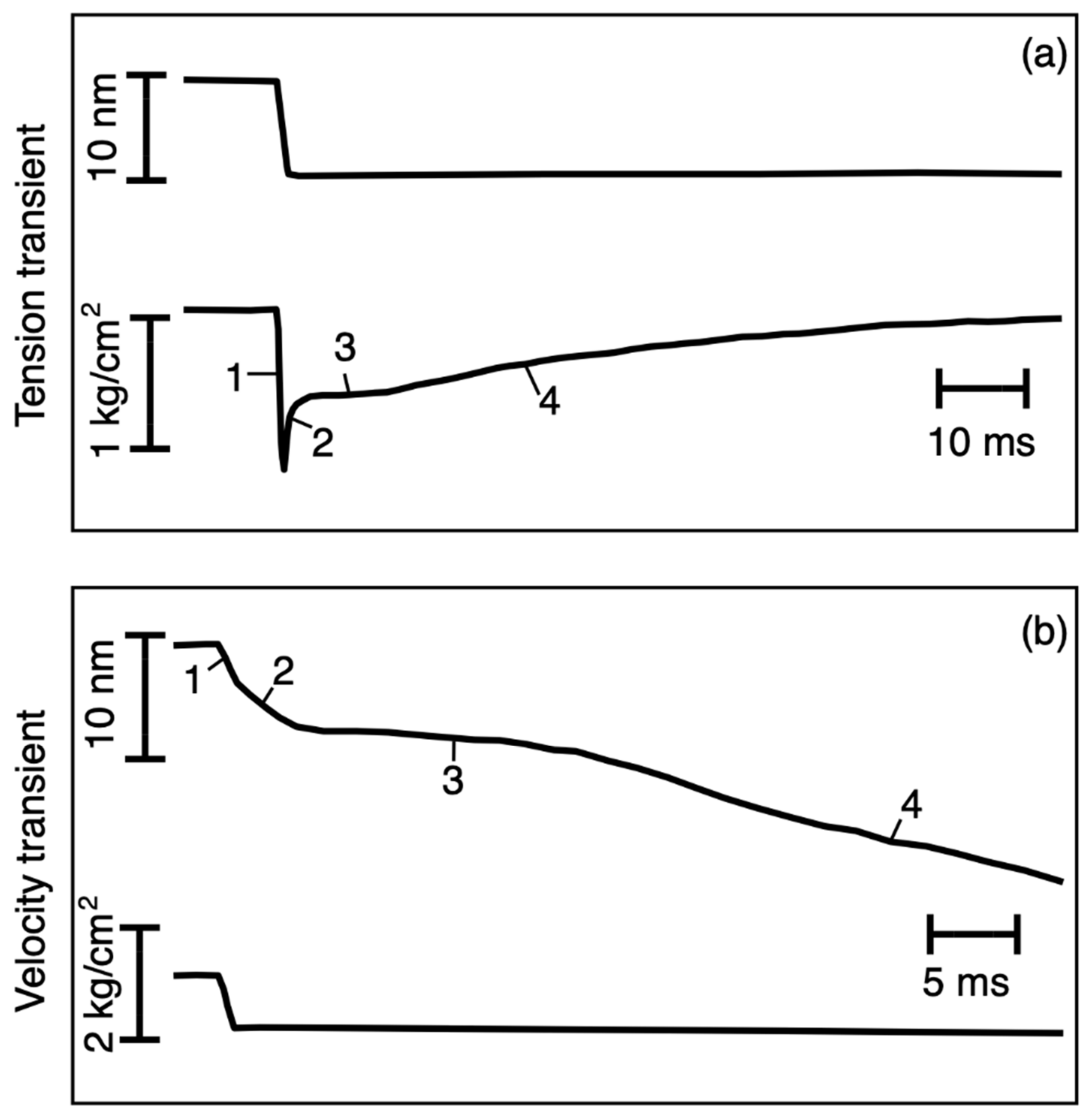
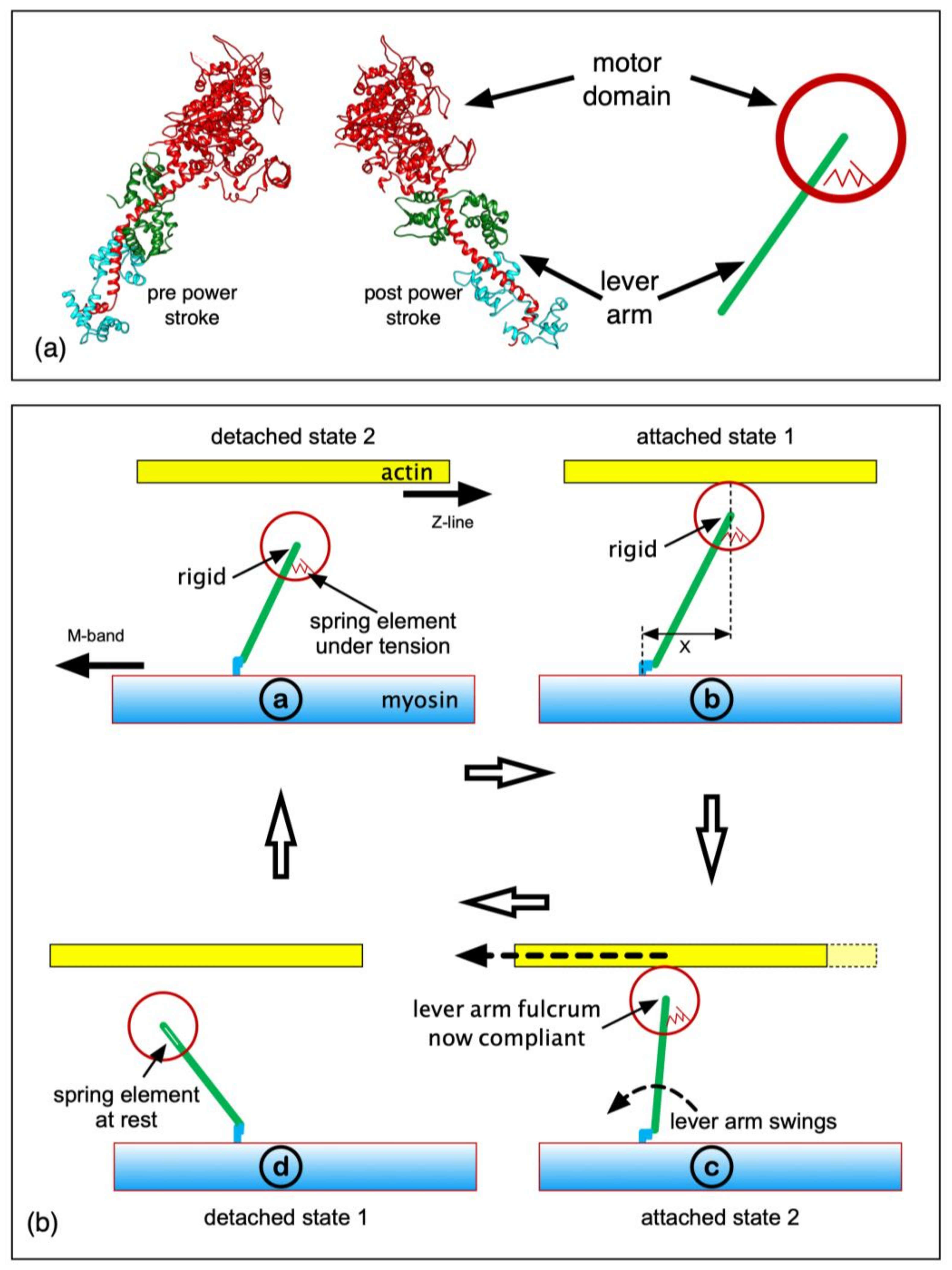
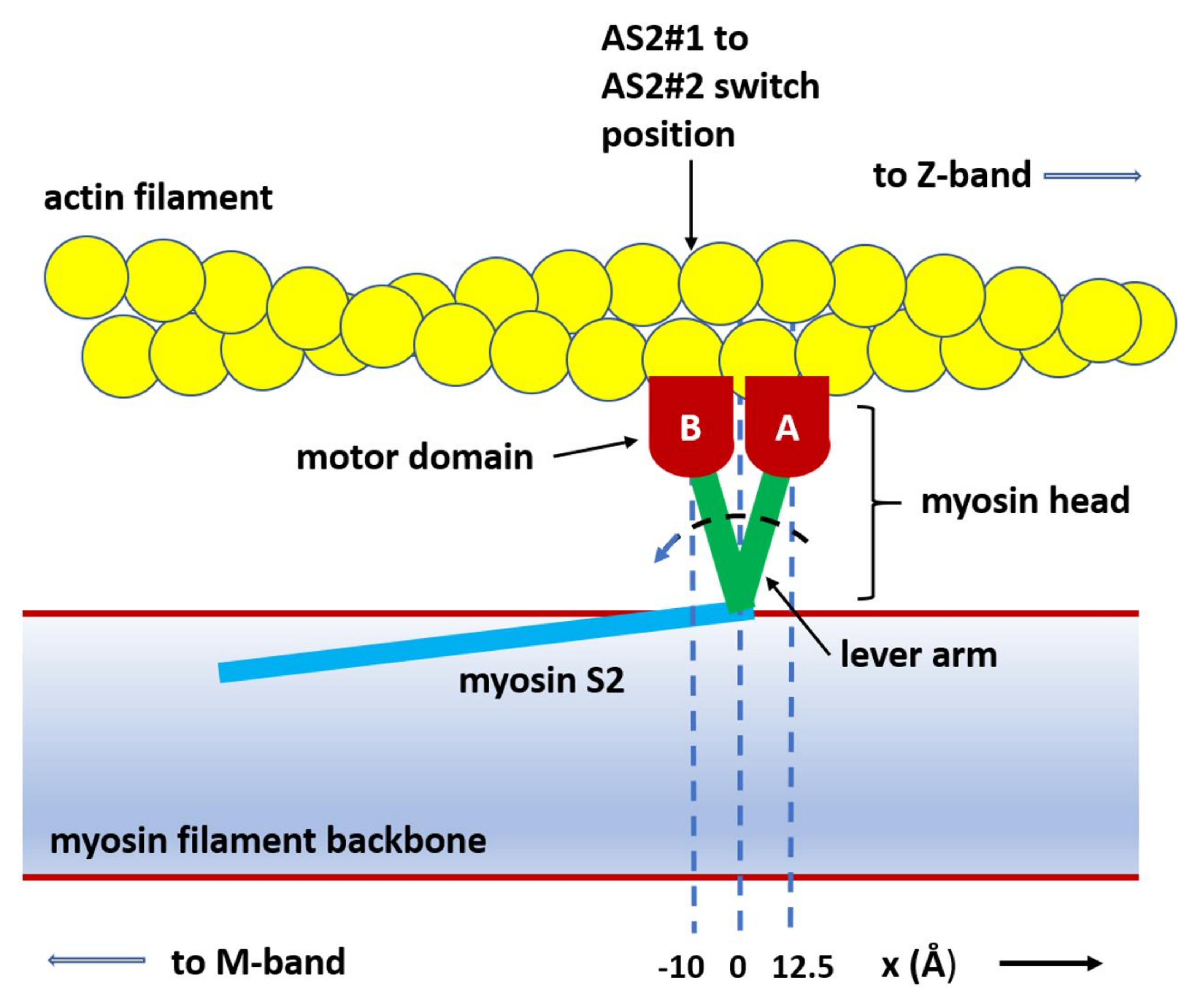
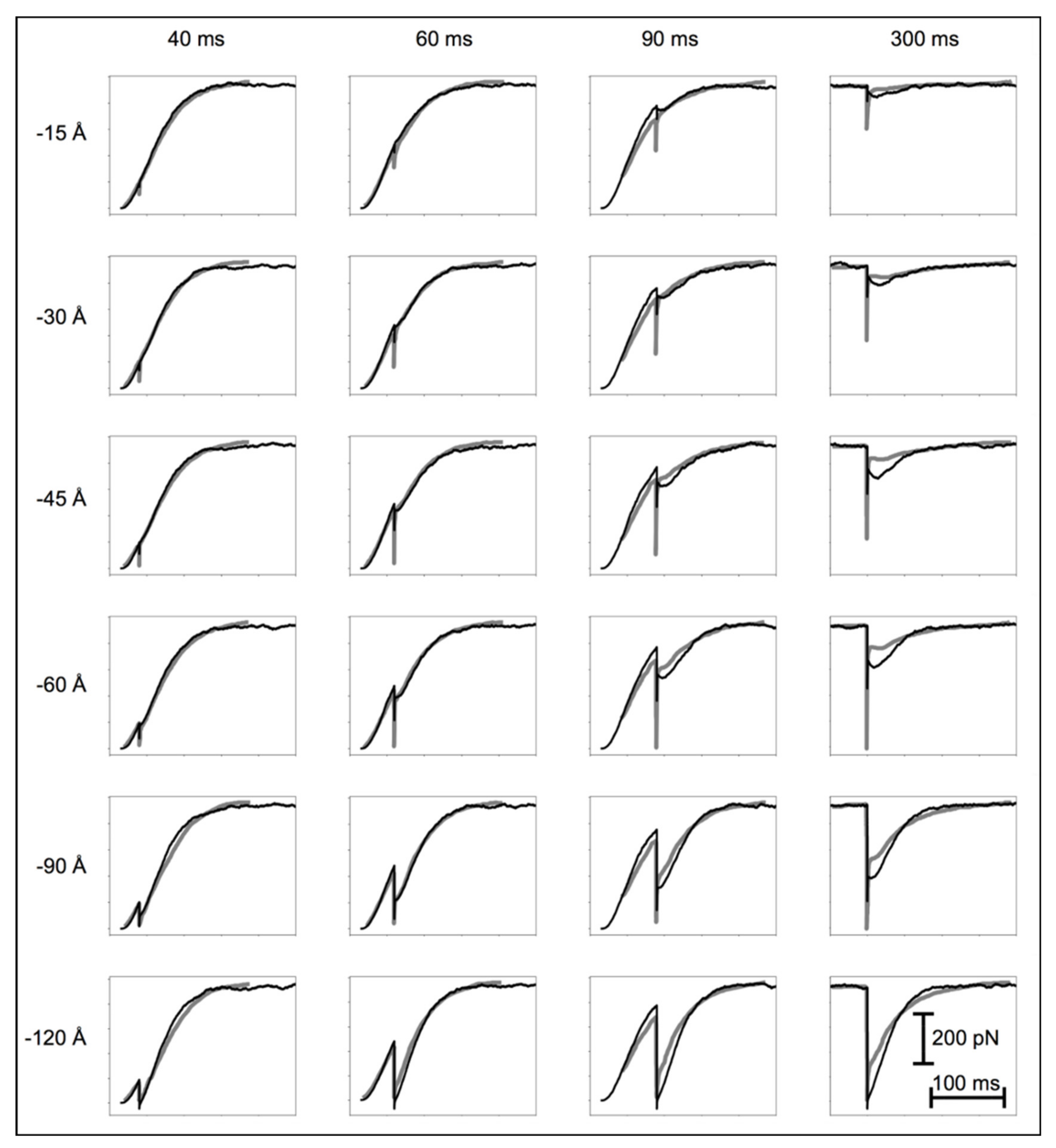

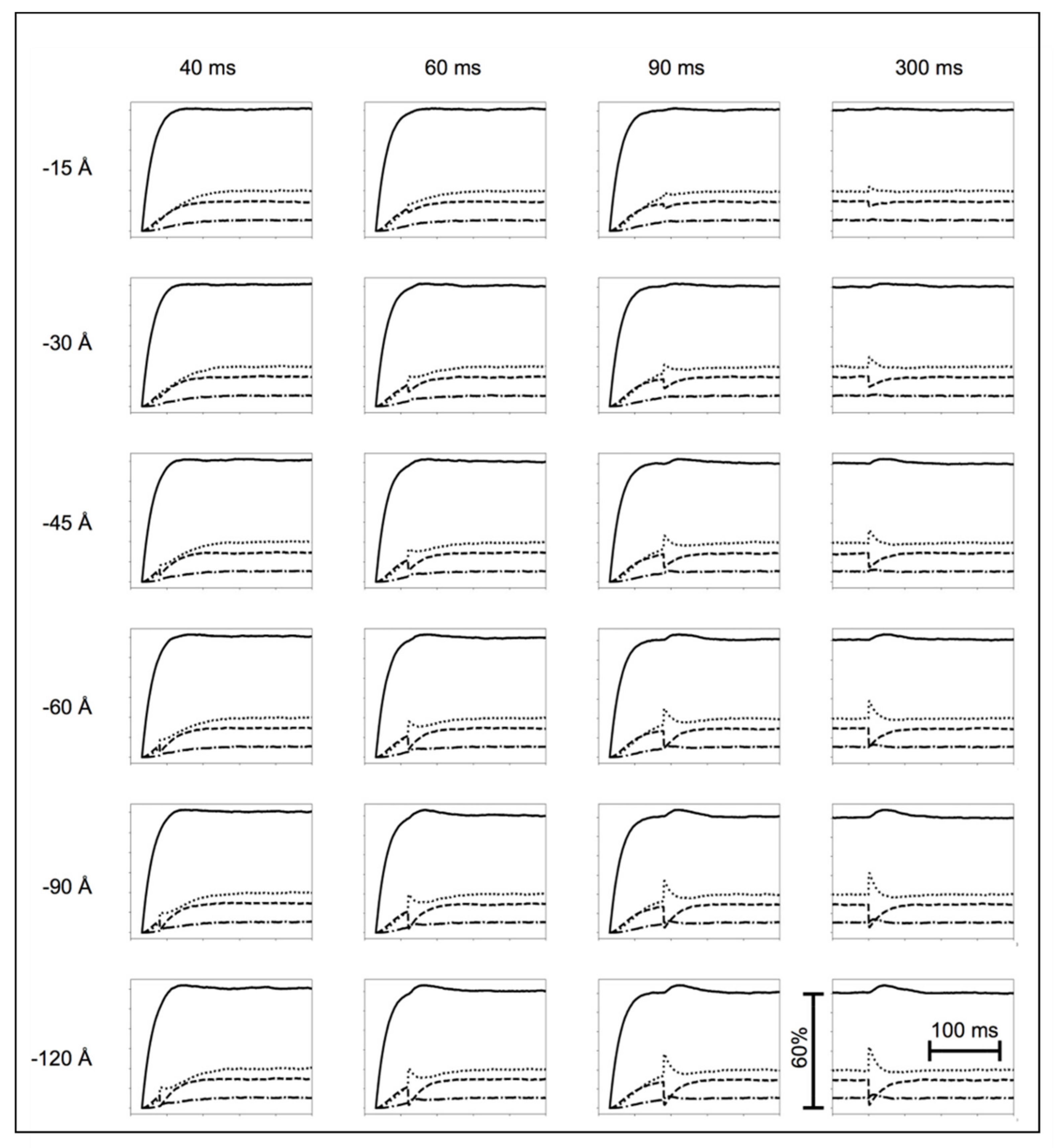
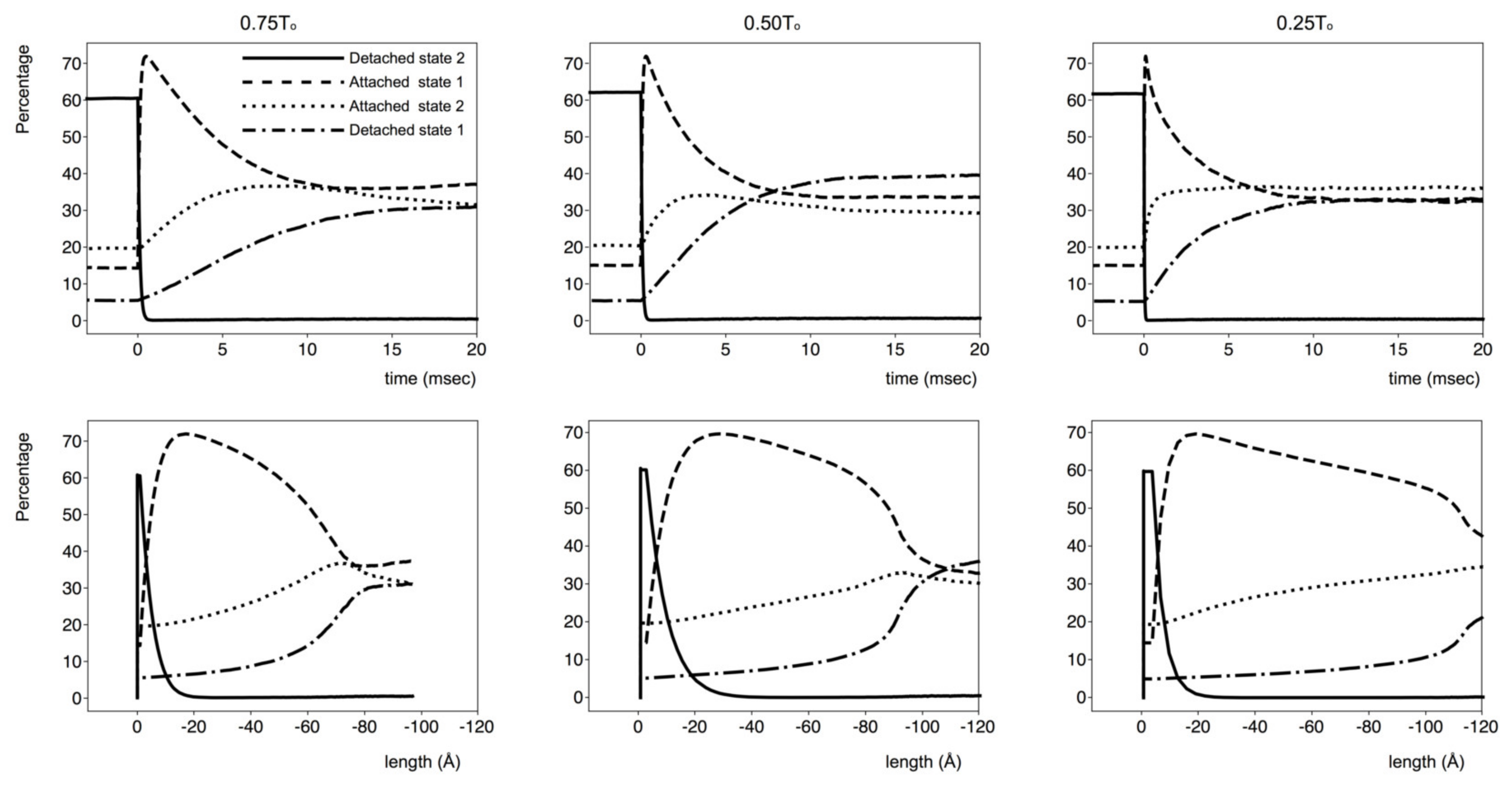

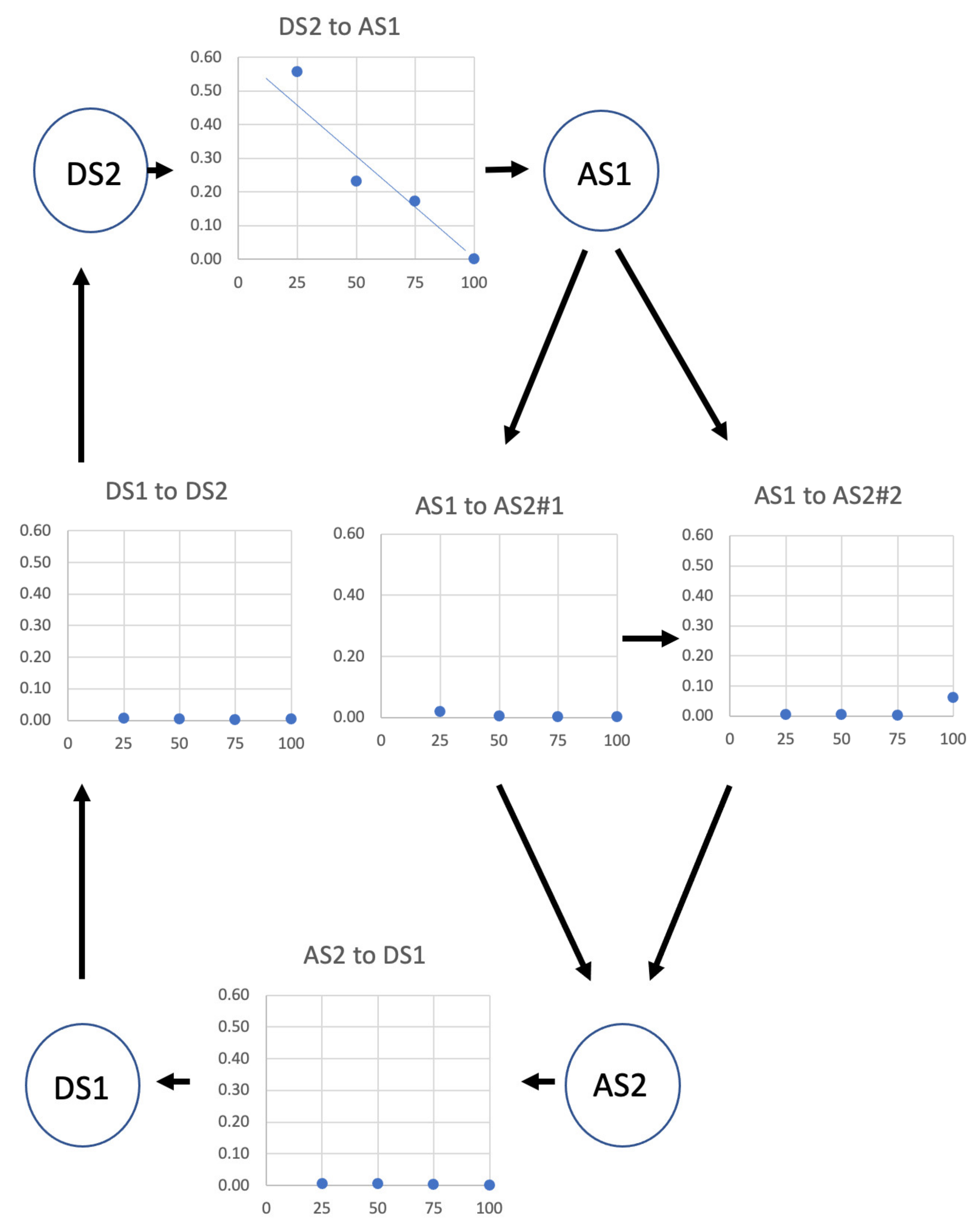

| Parameters | Length Step Simulation | Length Change Simulation When T = 25% to | Length Change Simulation When T = 50% to | Length Change Simulation When T = 75% to | Length Change Simulation When T = 100% to |
|---|---|---|---|---|---|
| Δt (ms) | 0.02 | 0.02 | 0.02 | 0.02 | 0.02 |
| Probability of cross-bridge activation [Δt−1] | 0.00080 | 0.00080 | 0.00080 | 0.00080 | 0.00080 |
| Probability of transition from DS2 to AS1 [Δt−1] | 0.00035 | 0.55678 | 0.23077 | 0.17251 | 0.00035 |
| Probability of transition from AS1 to AS2 #1 [Δt−1] | 0.00100 | 0.01893 | 0.00565 | 0.00143 | 0.00100 |
| Probability of transition from AS1 to AS2 #2 [Δt−1] | 0.06000 | 0.00381 | 0.00353 | 0.00285 | 0.06000 |
| Probability of transition from AS2 to DS1 [Δt−1] | 0.00107 | 0.00617 | 0.00498 | 0.00255 | 0.00107 |
| Probability of transition from DS1 to DS2 [Δt−1] | 0.00400 | 0.00681 | 0.00372 | 0.00257 | 0.00400 |
| Step size [Å] | 100.0 | 100.0 | 100.0 | 100.0 | 100.0 |
| Cross-bridge stiffness [pN Å−1] | 0.070 | 0.070 | 0.070 | 0.070 | 0.070 |
| AS2 to DS1 cutoff length [Å] | −10.00 | −10.00 | −10.00 | −10.00 | −10.00 |
| Cross-bridge attachment offset [Å] | 12.50 | 12.50 | 12.50 | 12.50 | 12.50 |
| Cross-bridge attachment spread (σ) [Å] | 46.25 | 46.25 | 46.25 | 46.25 | 46.25 |
| μ [pN ms Å−1] | n/a | 2.27 | 2.27 | 2.27 | 2.27 |
| Half bare zone (Å) | n/a | 821.29 | 821.29 | 821.29 | 821.29 |
| Centre of mass shift of attached heads (Å) | n/a | 26.16 | 26.16 | 26.16 | 26.16 |
| Weight of detached state 2 cross-bridges | n/a | 0.68 | 0.68 | 0.68 | 0.68 |
| Weight of attached state 1 cross-bridges | n/a | 1.12 | 1.12 | 1.12 | 1.12 |
| Weight of attached state 2 cross-bridges | n/a | 0.950 | 0.950 | 0.950 | 0.950 |
| Weight of detached state 1 cross-bridges | n/a | 0.001 | 0.001 | 0.001 | 0.001 |
| Sigma of detached cross-bridges (Å) | n/a | 37.500 | 37.500 | 37.500 | 37.500 |
| Centre of mass shift of extra Gaussians with 430 Å periodicity | n/a | 5.544 | 5.544 | 5.544 | 5.544 |
| Weight of extra Gaussians with 430 Å periodicity | n/a | 1.218 × 106 | 1.218 × 106 | 1.218 × 106 | 1.218 × 106 |
| Sigma of extra Gaussians with 430 Å periodicity | n/a | 60.075 | 60.075 | 60.075 | 60.075 |
| (For all length parameters, positive is towards the Z band.) |
Publisher’s Note: MDPI stays neutral with regard to jurisdictional claims in published maps and institutional affiliations. |
© 2020 by the authors. Licensee MDPI, Basel, Switzerland. This article is an open access article distributed under the terms and conditions of the Creative Commons Attribution (CC BY) license (http://creativecommons.org/licenses/by/4.0/).
Share and Cite
Knupp, C.; Squire, J.M. The Transient Mechanics of Muscle Require Only a Single Force-Producing Cross-Bridge State and a 100 Å Working Stroke. Biology 2020, 9, 475. https://doi.org/10.3390/biology9120475
Knupp C, Squire JM. The Transient Mechanics of Muscle Require Only a Single Force-Producing Cross-Bridge State and a 100 Å Working Stroke. Biology. 2020; 9(12):475. https://doi.org/10.3390/biology9120475
Chicago/Turabian StyleKnupp, Carlo, and John M. Squire. 2020. "The Transient Mechanics of Muscle Require Only a Single Force-Producing Cross-Bridge State and a 100 Å Working Stroke" Biology 9, no. 12: 475. https://doi.org/10.3390/biology9120475
APA StyleKnupp, C., & Squire, J. M. (2020). The Transient Mechanics of Muscle Require Only a Single Force-Producing Cross-Bridge State and a 100 Å Working Stroke. Biology, 9(12), 475. https://doi.org/10.3390/biology9120475





